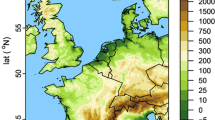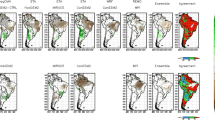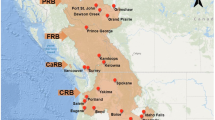Abstract
Future changes in extreme multi-day precipitation will influence the probability of floods in the river Rhine basin. In this paper the spread of the changes projected by climate models at the end of this century (2081–2100) is studied for a 17-member ensemble of a single Global Climate Model (GCM) and results from the Coupled Model Intercomparison Project Phase 3 (CMIP3) ensemble. All climate models were driven by the IPCC SRES A1B emission scenario. An analysis of variance model is formulated to disentangle the contributions from systematic differences between GCMs and internal climate variability. Both the changes in the mean and characteristics of extremes are considered. To estimate variances due to internal climate variability a bootstrap method was used. The changes from the GCM simulations were linked to the local scale using an advanced non-linear delta change approach. This approach uses climate responses of the GCM to transform the daily precipitation of 134 sub-basins of the river Rhine. The transformed precipitation series was used as input for the hydrological Hydrologiska Byråns Vattenbalansavdelning model to simulate future river discharges. Internal climate variability accounts for about 30 % of the total variance in the projected climate trends of average winter precipitation in the CMIP3 ensemble and explains a larger fraction of the total variance in the projected climate trends of extreme precipitation in the winter half-year. There is a good correspondence between the direction and spread of the changes in the return levels of extreme river discharges and extreme 10-day precipitation over the Rhine basin. This suggests that also for extreme discharges a large fraction of the total variance can be attributed to internal climate variability.





Similar content being viewed by others
References
Beersma JJ (2002) Rainfall generator for the Rhine basin: description of 1000-year simulations. Publication 186-V. Royal Netherlands Meteorological Institute (KNMI), De Bilt
Bergström S, Forsman A (1973) Development of a conceptual deterministic rainfall runoff model. Nord Hydrol 4:147–170
Brekke LD, Barsugli JJ (2013) Uncertainties in projections of future changes in extremes. In: AghaKouchak A, Easterling D, Hsu K, Schubert S, Sorooshian S (eds) Extremes in a changing climate. Springer, Netherlands, pp 309–346. doi:10.1007/978-94-007-4479-0_11
Buishand TA, Brandsma T (2001) Multisite simulation of daily precipitation and temperature in the Rhine basin by nearest-neighbor resampling. Water Resour Res 37(11):2761–2776
Cox P, Stephenson D (2007) A changing climate for prediction. Science 317(5835):207–208. doi:10.1126/science.1145956
De Wit MJM, Buishand TA (2007) Generator of rainfall and discharge extremes (GRADE) for the Rhine and Meuse basins. Rijkswaterstaat RIZA Report no. 2007.027/KNMI publication 218. Lelystad/De Bilt, the Netherlands
Delworth TL, Broccoli AJ, Rosati A, Stouffer RJ, Balaji V, Beesley JA, Cooke WF, Dixon KW, Dunne J, Dunne K (2006) GFDL’s CM2 global coupled climate models. Part I: formulation and simulation characteristics. J Clim 19(5):643–674
Disse M, Engel H (2001) Flood events in the Rhine basin: genesis, influences and mitigation. Nat Hazards 23(2):271–290. doi:10.1023/a:1011142402374
Flato G (2005) The third generation coupled global climate model (CGCM3) (http://www.ec.gc.ca/ccmac-cccma/default.asp?lang=En&n=1299529F). Canadian Centre for Climate Modelling and Analysis: Canada
Giorgi F, Bi X (2009) Time of emergence (TOE) of GHG-forced precipitation change hot-spots. Geophys Res Lett 36(6):L06709. doi:10.1029/2009gl037593
Gordon C, Cooper C, Senior CA, Banks H, Gregory JM, Johns TC, Mitchell JFB, Wood RA (2000) The simulation of SST, sea ice extents and ocean heat transports in a version of the Hadley Centre coupled model without flux adjustments. Clim Dyn 16(2):147–168. doi:10.1007/s003820050010
Gordon H, Rotstayn L, McGregor J, Dix M, Kowalczyk E, O’Farrell S, Waterman L, Hirst A, Wilson S, Collier M (2002) The CSIRO Mk3 climate system model. Technical Paper No. 60. CSIRO Atmospheric Research, Aspendale, Australia
Hasumi H, Emori S (2004) K-1 coupled model (MIROC) description. Center for Climate System Research, University of Tokyo, Tokyo
Hawkins E, Sutton R (2009) The potential to narrow uncertainty in regional climate predictions. Bull Am Meteorol Soc 90(8):1095–1107. doi:10.1175/2009bams2607.1
Hawkins E, Sutton R (2011) The potential to narrow uncertainty in projections of regional precipitation change. Clim Dyn 37(1):407–418. doi:10.1007/s00382-010-0810-6
Hegerl GC, Zwiers FW, Stott PA, Kharin VV (2004) Detectability of anthropogenic changes in annual temperature and precipitation extremes. J Clim 17(19):3683–3700. doi:10.1175/1520-0442
Kallache M, Vrac M, Naveau P, Michelangeli P (2011) Nonstationary probabilistic downscaling of extreme precipitation. J Geophys Res 116(D05113). doi:10.1029/2010JD014892
Kay AL, Davies HN, Bell VA, Jones RG (2009) Comparison of uncertainty sources for climate change impacts: flood frequency in England. Clim Change 92(1):41–63
Kendon EJ, Rowell DP, Jones RG, Buonomo E (2008) Robustness of future changes in local precipitation extremes. J Clim 21(17):4280–4297
Kew SF, Selten FM, Lenderink G, Hazeleger W (2011) Robust assessment of future changes in extreme precipitation over the Rhine basin using a GCM. Hydrol Earth Syst Sci 15(4):1157–1166
Leander R, Buishand TA (2007) Resampling of regional climate model output for the simulation of extreme river flows. J Hydrol 332(3–4):487–496
Marti O, Braconnot P, Bellier J, Benshila R, Bony S, Brockmann P, Cadule P, Caubel A, Denvil S, Dufresne J, Fairhead L, Filiberti MA, Fichefet T, Foujols MA, Friedlingstein P, Grandpeix JY, Hourdin F, Krinner G, Lévy C, Madec G, Musat L, De Noblet M, Polcher J, Talandier C (2006) The new IPSL climate system model: IPSLCM4. Inst. Pierre Simon Laplace des Sciences de l’Environnement Global, Paris
Meehl GA, Stocker TF, Collins WD, Friedlingstein P, Gaye AT, Gregory JM, Kitoh A, Knutti R, Murphy JM, Noda A, Raper SCB, Watterson IG, Weaver AJ, Zhao ZC (2007) Global climate projections. In: Solomon S, Qin D, Manning M, Chen Z, Marquis M, Averyt KB, Tignor M, Miller HS (eds) Climate change 2007: The physical science basis. Contribution of working Group I to the fourth assessment report of the intergovernmental panel on climate change. Cambridge University Press, Cambridge, pp 747–846
Min S, Legutke S, Hense A, Kwon W (2005) Internal variability in a 1000-year control simulation with the coupled climate model ECHO-G-I. Near-surface temperature, precipitation and mean sea level pressure. Tellus 57(4):605–621
Murphy JM, Sexton DMH, Barnett DN, Jones GS, Webb MJ, Collins M, Stainforth DA (2004) Quantification of modelling uncertainties in a large ensemble of climate change simulations. Nature 430(7001):768–772
Photiadou CS, Weerts AH, Van den Hurk BJJM (2011) Evaluation of two precipitation data sets for the Rhine River using streamflow simulations. Hydrol Earth Syst Sci 15(11):3355–3366
Räisänen J (2001) CO2-induced climate change in CMIP2 experiments: quantification of agreement and role of internal variability. J Clim 14(9):2088–2104. doi:10.1175/1520-0442(2001)014
Räisänen J, Joelsson R (2001) Changes in average and extreme precipitation in two regional climate model experiments. Tellus A 53(5):547–566. doi:10.1034/j.1600-0870.2001.00262.x
Räisänen J, Palmer T (2001) A probability and decision-model analysis of a multimodel ensemble of climate change simulations. J Clim 14(15):3212–3226
Roeckner E, Bäuml G, Bonaventura L, Brokopf R, Esch M, Giorgetta M, Hagemann S, Kirchner I, Kornblueh L, Manzini E, Rhodin A, Schlese U, Schulzweida U, Tompkins A (2003) The atmospheric general circulation model ECHAM5. Part I: model description. Report No. 349. Max Planck Institute for Meteorology Hamburg
Roth M, Buishand TA, Jongbloed G, Klein Tank AMG, Van Zanten JH (2012) A regional peaks-over-threshold model in a non-stationary climate. Water Resour Res 48 (W11533). doi:10.1029/2012WR01221
Rowell DP (2012) Sources of uncertainty in future changes in local precipitation. Clim Dyn 39(7–8):1929–1950. doi:10.1007/s00382-011-1210-2
Salas-Mélia D, Chauvin F, Déqué M, Douville H, Gueremy J, Marquet P, Planton S, Royer J, Tyteca S (2005) Description and validation of the CNRM-CM3 global coupled model. CNRM working note, available at: http://www.cnrm.meteo.fr/scenario2004/papercm3.pdf. Centre National de Recherches Météorologiques (CNRM), Météo France, Toulouse
Shabalova MV, Van Deursen WPA, Buishand TA (2003) Assessing future discharge of the river Rhine using regional climate model integrations and a hydrological model. Clim Res 23(3):233–246
Sterl A, Severijns C, Dijkstra H, Hazeleger W, Van Oldenborgh GJ, Van den Broeke M, Burgers G, Van den Hurk BJJM, Van Leeuwen PJ, Van Velthoven P (2008) When can we expect extremely high surface temperatures? Geophys Res Lett 35(14):L14703. doi:10.1029/2008gl034071
Stuart A, Ord JK (1987) Kendall’s advanced theory of statistics, vol 1. Distribution theory, 5th edn. Charles Griffin London, UK
Ulbrich U, Fink A (1995) The January 1995 flood in Germany: meteorological versus hydrological causes. Phys Chem Earth 20(5–6):439–444
Van Pelt SC, Beersma JJ, Buishand TA, Van den Hurk BJJM, Kabat P (2012) Future changes in extreme precipitation in the Rhine basin based on global and regional climate model simulations. Hydrol Earth Syst Sci 16:4517–4530. doi:10.5194/hess-16-4517-2012
Weiss J, Bernardara P (2013) Comparison of local indices for regional frequency analysis with an application to extreme skew surges. Water Resour Res 49(5):2940–2951. doi:10.1002/wrcr.20225
Weissman I (1978) Estimation of parameters and larger quantiles based on the k largest observations. J Am Stat Assoc 73(364):812–815
Wójcik R, Beersma JJ, Buishand T (2000) Rainfall generator for the Rhine basin. Multi-site generation of weather variables for the entire drainage area. Publication 186-V. Royal Netherlands Meteorological Institute (KNMI), De Bilt
Yukimoto S, Noda A, Kitoh A, Hosaka M, Yoshimura H, Uchiyama T, Shibata K, Arakawa O, Kusunoki S (2006) Present-day climate and climate sensitivity in the meteorological research institute coupled GCM version 2.3 (MRI-CGCM2. 3). J Meteorol Soc Jpn 84(2):333–363
Acknowledgments
This research was carried out in the framework of the Dutch National Research Programme “Knowledge for Climate”. We thank Pavel Kabat for discussion on the content and an anonymous reviewer for valuable comments. We acknowledge the modelling groups, the Program for Climate Model Diagnosis and Intercomparison (PCMDI) and the WCRP’s Working Group on Coupled Modelling (WGCM) for their roles in making available the WCRP CMIP3 multi-model dataset. Support of this dataset is provided by the Office of Science, U.S. Department of Energy.
Author information
Authors and Affiliations
Corresponding author
Rights and permissions
About this article
Cite this article
van Pelt, S.C., Beersma, J.J., Buishand, T.A. et al. Uncertainty in the future change of extreme precipitation over the Rhine basin: the role of internal climate variability. Clim Dyn 44, 1789–1800 (2015). https://doi.org/10.1007/s00382-014-2312-4
Received:
Accepted:
Published:
Issue Date:
DOI: https://doi.org/10.1007/s00382-014-2312-4




